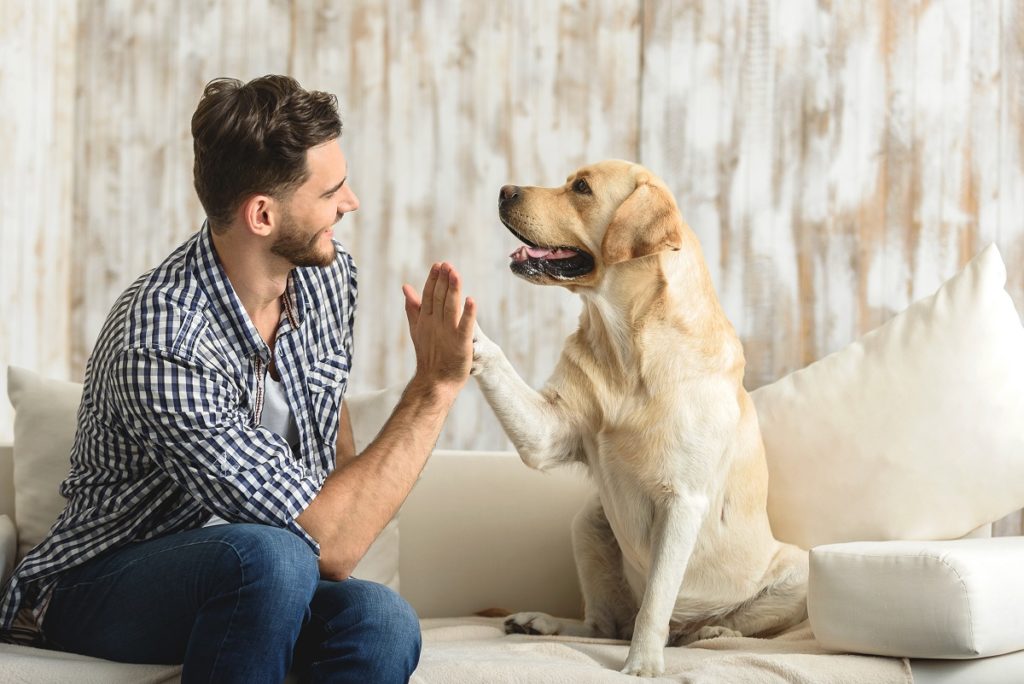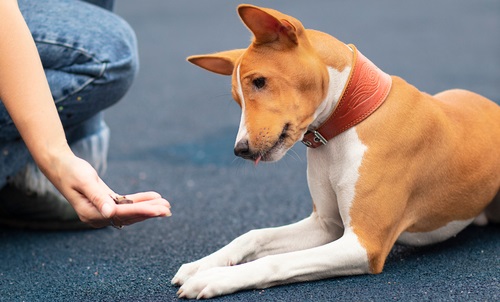As wonderful as our furry friends are, it’s safe to say that dogs aren’t always on their best behavior. If your canine companion has a few habits you’d like to see less of (as in, a lot less of), chances are you’re looking for a way to encourage some better behavior from your furry friend.
Perhaps it’s time to try positive reinforcement dog training.
Whether your learning how to train an emotional support dog or just a regular family pup, getting your dog to do what you want involves more than a couple of pats and scratches, it’s about reinforcing behavior through repetition. This guide will take you through how the process works and explore the best positive reinforcement dog training methods around. Read on for the tools you need to ensure a well-mannered pup.
How Does Positive Reinforcement Training Work?
To put it simply, positive reinforcement training means using a reward to encourage desired behavior. It’s about modifying behavior to receive the desired outcome, and in this case, it’s beneficial for both you and your pup.
While there’s plenty we don’t understand about what goes on in your dog’s head, generations of domesticating canines have led to some serious study about doggy psychology.
Positive reinforcement training is all about pragmatic and beneficial ways to encourage your dog to act their best. In addition, positive reinforcement has been linked to better training results when used without any negative discipline.
Some of the key tenants of positive reinforcement training include:
- Building a bond – Your dog is your loyal companion, and you are the center of their world. Positive reinforcement can strengthen that special bond between you and your dog. While you can always hire a trainer to teach your dog to behave, doing it yourself can make for an even more special relationship.
- Opening communication – If only your dog could understand the words coming out of your mouth. Well, with positive reinforcement, your dog will have a better idea of what causes positive outcomes for both you and your pet.
- Developing patience – Dogs aren’t necessarily known for their patience, but with positive reinforcement, you can instill a level of restraint you may have never thought possible. Through consistent rewards, your dog will develop the ability to keep their composure in a number of situations, knowing that they always have something to look forward to.
- Staying engaged – Introducing a little more stimulation into your dog’s life can help with their mental and physical health. The mental engagement required for training can do wonders for a pup. Plus, the training should always be combined with walks, playtime, and snuggle time to keep you and your dog feeling great.
What Doesn’t Work: Carrot and the Stick
Before we knew about the best practices for dog training, people used to subscribe to the old “carrot and stick” version of dog training.
In case you’re not familiar with this outdated form of training, consider these short explanations:
- Carrot – In this case, the carrot refers to a reward. Something good that the dog can earn through the proper behavior.
- Stick – The stick is negative discipline. Whether it’s a literal thwap or just some chastising words, the stick was thought of as the counterbalance for a misbehaving dog.
Over the years, dog owners, vets, and animal professionals have learned that “the stick” is a bad call when it comes to dog training. Harsh discipline can lead to a stressed or irritable dog, as they don’t have the complex cognitive skills to always understand why they’re being punished.
The 3 Key Aspects of Positive Reinforcement Training
Now that we’ve covered the basics of positive reinforcement training, it’s time to investigate the best ways to implement this highly effective instructional method.
#1 Choosing A Winning Reward
There’s plenty to be said about the wide variety of dog personalities, but there’s one thing all pups have in common—they love tasty treats.
Whether your dog loves peanut butter, sweet apples, or savory maple bacon dog treats, there’s a treat that will catch their eye and leave their mouth-watering. That said, it may take a little help picking out the treatment that will work best for positive reinforcement training.
Consider these tips when searching for the right edible reward for your pooch:
- Pay attention to size – You’re going to be handing out so many treats, it’s going to feel like Halloween for your pup. That’s why it’s essential to keep treat size to a minimum, close to the size of a pencil eraser. Fortunately, that doesn’t mean you’re stuck to browsing for the most mini of doggy treats, just be sure to break up bigger treats into bite-sized portions.
- Health-conscious snacking – Treats are certainly supposed to be enjoyable, but that doesn’t mean they have to be total junk food. When picking out your dog’s training treat, look for high-quality, organic snack options that don’t have added dyes and fillers.
- Consider some meal modification – If you’re having some treat-heavy training sessions, it could be useful to offer a slightly smaller dinner for your furry friend. Avoiding upset tummies and an overstuffed dog should always be a priority.
For those interested in giving their dog an extra boost during their positive reinforcement training, it’s worthwhile to check out hemp-CBD dog treats. These tasty morsels could help your dog throughout the training process and could quickly become their favorite snack. For special occasions, check out our dog birthday cake recipe to really show your pup the love.
#2 Creating A Consistent Reward System
Once you have the proper treats in hand, the next step is creating a reliable and stable method of using them.
First, determine the best times to implement training. Based on what’s worked for others, we’d encourage the following training times:
- Before letting your dog outside
- Before pets and playtime
- Before their breakfast or dinner
These could be seen as the most opportune moments to grab your dog’s attention and encourage good behavior.
Consistency is also an absolute necessity. If you’re co-training your dog with a partner or family member, make sure everyone is on the same page. You should be delivering treats in the same way and at the same time to ensure your dog associates the correct behavior with the reward.
In addition, it could be helpful to keep the following details in mind when providing positive reinforcement:
- Time your treats – Make each treat count by getting them to your pup promptly. Your dog doesn’t have the greatest short-term memory, so if you wait too long to get them their treat, they may forget what it’s for. Be sure the treat arrives the moment your dog completes the requested behavior to avoid any confusion.
- Up the requirements – As your dog begins to master certain behaviors—be it sit, stay, or come here—start asking a little more of them to earn a treat. This way, you can build up more complex skills and slowly acclimate them to commands that require a little more time to fully grasp.
- Avoid reinforcing bad behavior – While you’re trying your best to only provide treats for good behavior, you may find yourself slipping or trying to bribe your dog. If you end up using treats to encourage your pup to stop barking or acting out, it may complicate the training process and lead them to continue their misbehavior.
#3 Adding In Some Vocal Cues
Your dog might not speak English, but they still love it when you talk to them.
Vocal cues, encouragement, and praises are a big part of positive reinforcement dog training. While it’s typically thought that dogs respond more directly to body language, you can begin using words to add another layer of their training.
When it comes to training commands, some of the most popular include:
- Sit
- Up
- Come
- Drop or give
- Stay
- Down
- Off
- Watch
You can start adding these words to your training, focusing on associating the right behavior and the right word in your dog’s mind.
When teaching these commands, keep in mind the following:
- Short and sweet – Don’t extend the commands to anything more than a word or two. Long sentences will likely be lost on your pooch, and we wouldn’t recommend any 10-dollar words. In addition, avoid combining multiple commands. Keep “sit,” “down,” and “off,” separated by a pause or two.
- Watch your tone – How you say something can be even more important than what you say. This is especially true when dealing with dogs. Keep your tone excited and encouraging throughout your training sessions. You may even find yourself discovering a special pet voice that your dog responds to.
- Stay calm – It’s not always easy to train your pup and more likely than not, there are going to be a few frustrating moments along the way. Instead of getting irritated at your four-legged friend, make sure to take a deep breath and remember that they’re trying their best.
Of course, there’s more to positive reinforcement than just kind words and tasty treats. Offer your dog a variety of rewards to keep the training exciting and fun. A new toy, an extended walk, or a trip to the dog park can all be ways to encourage good behavior and have a great time while doing it. Even trying new flavors of treats like banana biscuits for dogs can add excitement. The whole experience should be a positive one.
Bring Out The Best of Your Training with Canna-Pet
Ready for a canine companion with manners, class, and a friendly disposition? With these helpful tips, you should have all you need to start to bring your positive reinforcement training to the next level. In addition, if you’re looking for the perfect treat to make the most of each training session, check out Canna-Pet.
At Canna-Pet, we’ve developed powerfully delicious products that are beloved by dogs and recommended by vets. Whether your dog’s looking for sweet or savory, Canna-Pet has an organic treat to hit the spot and deliver all the added benefits of CBD. Try Canna-Pet for your next training session—you might see some truly inspiring results.
Sources:
- Companion Animal Psychology. Part VI of Positive Reinforcement and Dog Training: Learning New Behaviours. https://www.companionanimalpsychology.com/2012/08/part-vi-of-positive-reinforcement-and.html
- The Humane Society. Positive reinforcement training. https://www.humanesociety.org/resources/positive-reinforcement-training
- RAU Animal Hospital. The Secret to Dog Training: Why Positive Reinforcement Works But Punishment Doesn’t. https://www.rauanimalhospital.com/resources/blog/dogs/secret-dog-training-why-positive-reinforcement-works-punishment-doesnt






